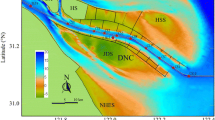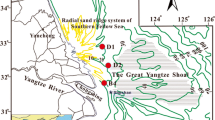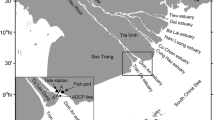Abstract
In October of 2004, a 3-d observational program to measure flow and sediment resuspension within a coastal intertidal salt marsh was conducted in the North Inlet/Winyah Bay National Estuarine Research Reserve located near Georgetown, South Carolina. Current and acoustic backscatter profiles were obtained from a moored acoustic Doppler current profiler (ADCP) deployed in a shallow tidal channel during the spring phase of the tidal cycle under high discharge conditions. The channel serves as a conduit between Winyah Bay, a large brackish estuary, and North Inlet, a saline intertidal coastal salt marsh with little freshwater input. Salinity measurements indicate that the water column is vertically well mixed during flood, but becomes vertically stratified during early ebb. The stratification results from brackish (15 psu) Winyah Bay water entering North Inlet via the tidal channel, suggesting an exchange mechanism that permits North Inlet to receive a fraction of the poor water quality and high discharge flow from upland rivers. Although maximum flood currents exceed maximum ebb currents by 0.2 m s−1, suspended sediment concentrations are highest during the latter ebb phase and persist for a longer fraction of the ebb cycle. Even though the channel is flood-dominated, the higher concentrations occurring over a longer fraction of the ebb phase indicate net particulate transport from Winyah Bay to North Inlet during spring tide accompanied by high discharge. Our evidence suggests that the higher concentrations during ebb result from increased bed friction caused by flow asymmetries and variations in water depth in which the highest stresses occur near the end of ebb near low water despite stronger maximum currents during flood.
Similar content being viewed by others
References
Blanton, J. O., H. Seim, C. Alexander, J. Amft, andG. Kineke. 2003. Transport of salt and suspended sediments in a curving channel of a coastal plain estuary: Satilla River, GA.Estuarine Coastal and Shelf Science 57:993–1006.
Buzzelli, C., O. Akman, T. Buck, E. Koepfler, J. Morris, andA. Lewitus. 2004. Relationships among water-quality parameters from the North Inlet-Winyah Bay National Estuarine Research Reserve, South Carolina.Journal of Coastal Research 45:59–74.
Dame, R., T. Chrzanowski, K. Bildstein, B. Kjerfve, H. McKellar, D. Nelson, J. Spurrier, S. Stancyk, H. Stevenson, J. Vernberg, andR. Zingmark. 1986. The Outwelling Hypothesis and North Inlet, South-Carolina.Marine Ecology-Progress Series 33:217–229.
Deines, K. L. 1999. Backscatter Estimation Using Broadband Acoustic Doppler Current Profilers, p. 249–253.In IEEE Sixth Working Conference on Current Measurement. San Diego, California.
Dronkers, J. 1986. Tidal Asymmetry and Estuarine Morphology.Netherlands Journal of Sea Research 20:117–131.
Friedrichs, C. T. andD. G. Aubrey. 1988. Non-Linear Tidal Distortion in Shallow Well-mixed Estuaries: A Synthesis.Estuarine Coastal and Shelf Science 27:521–545.
Fugate, D. and R. Chant. 2005. Near-bottom shear stresses in a small, highly stratified estuary.Journal of Geophysical Research-Oceans Volume 110, C03022., doi: 10.1029/2004JC002563.
Gardner, L. R. andD. E. Porter. 2001. Stratigraphy and geologic history of a southeastern salt marsh basin, North Inlet, South Carolina, U.S.A.,Wetlands Ecology and Management 9:371–385.
Goni, M., M. W. Cathey, Y. Kim, andG. Voulgaris. 2005. Fluxes and sources of suspended organic matter in an estuarine turbidity maximum region during low discharge conditions.Estuarine Coastal and Shelf Science 63:683–700.
Glenn, S. M. andW. D. Grant. 1987. A suspended sediment stratification correction for combined wave and current flows.Journal of Geophysical Research 92:8244–8264.
Grant, W. D., A. J. Williams III, andS. M. Glenn. 1984. Bottom stress estimates and their prediction on the northern California continental shelf during CODE-1: The importance of wave-current interaction.Journal of Physical Oceanography 14:506–527.
Gross, T. F., A. E. Isley, andC. R. Sherwood. 1992. Estimation of stress and bed roughness during storms on the Northern California Shelf.Continental Shelf Research 12:389–413.
Gross, T. F. andA. R. M. Nowell. 1983. Mean flow and turbulence scaling in a tidal boundary layer.Continental Shelf Research 2:109–126.
Jenter, H. L. andO. S. Madsen. 1989. Bottom Stress in Wind-Driven Depth-Averaged Coastal Flows.Journal of Physical Oceanography 19:962–974.
Kjerfve, B., L. B. Miranda, andE. Wolanski. 1991. Modeling Water Circulation in an Estuary and Intertidal Salt-Marsh System.Netherlands Journal of Sea Research 28:141–147.
Mofjeld, H. O. 1988. Depth Dependence of Bottom Stress and Quadratic Drag Coefficient for Barotropic Pressure-Driven Currents.Journal of Physical Oceanography 18:1658–1669.
Neter, J., W. Wasserman, andM. H. Kutner. 1989. Applied Linear Regression Models, 2nd edition. Irwin, Homewood, Illinois.
Nielsen, P. 1992. Coastal Bottom Boundary Layers and Sediment Transport. Advanced Series on Ocean Engineering, 4, World Scientific, New York.
Schwing, F. B. andB. Kjerfve. 1980. Longitudinal characterization of a tidal marsh creek separating two hydrographically distinct estuaries.Estuaries 3:236–241.
Smith, J. D. andS. R. McLean. 1977. Spatially averaged flow over a wavy surface.Journal of Geophysical Research 82:1735–1746.
Vogel, R. L., B. Kjerfve, andL. R. Gardner. 1996. Inorganic Sediment Budget for the North Inlet Salt Marsh, South Carolina, U.S.A..Mangroves and Salt Marshes 1:23–35.
Wargo, C. A. 2005. Along Channel Flow and Sediment Dynamics at North Inlet, South Carolina, M.S. Thesis, University of South Carolina, Columbia, South Carolina.
Warner, J. C., D. Schoellhamer, andG. Schladow. 2003. Tidal truncation and barotropic convergence in a channel network tidally driven from opposing entrances.Estuarine Coastal and Shelf Science 56:629–639.
Yalin, M. S. 1992. River Mechanics, 1st edition. Pergammon, Oxford.
Sources of Unpublished Materials
Goni, M. personal communication. College of Oceanic and Atmospheric Sciences, 104 Ocean Administration Bldg., Oregon State University, Corvallis, Oregon 97331-5503.
Author information
Authors and Affiliations
Corresponding author
Rights and permissions
About this article
Cite this article
traynum, S., Styles, R. Flow, stress and sediment resuspension in a shallow tidal channel. Estuaries and Coasts: J ERF 30, 94–101 (2007). https://doi.org/10.1007/BF02782970
Received:
Accepted:
Issue Date:
DOI: https://doi.org/10.1007/BF02782970




